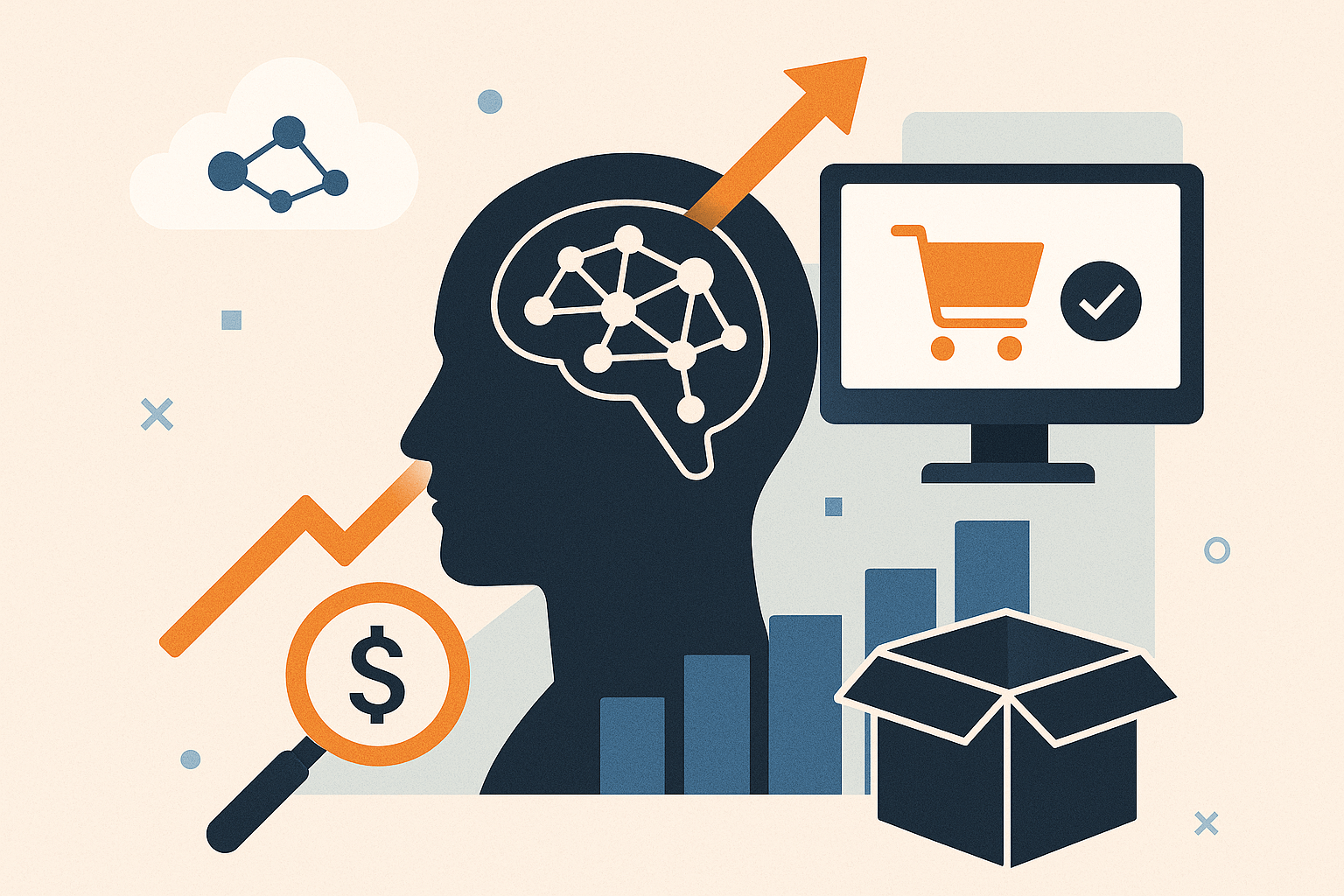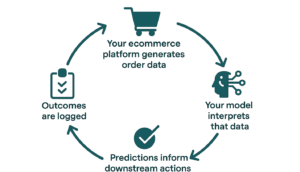Why You’re Losing Margin Before the Order Drops
Let’s stop pretending reorders are random. In industrial B2B ecommerce, they rarely are.
That East Coast HVAC contractor who restocks ¼-inch elbows every 30 to 35 days? The Tier 1 auto supplier whose six-week hose order is practically muscle memory? These aren’t anomalies. They’re patterns, quiet ones, buried under dirty data, split invoices, and forgotten spreadsheets. And every time your BigCommerce system fails to recognize that rhythm, your margin bleeds.
- You stock the wrong parts “just in case,” tying up cash.
- You missed reorders that should have been automatic.
- You call in air freight to save a client relationship that never needed to be endangered.
This isn’t a failure of effort. It’s a failure of foresight.
And it’s not because you lack data. You have everything: SKUs, timestamps, reorder histories, and account-level nuances. What you lack is a model that listens. A system that doesn’t just show what happened, but sees what’s coming.
Machine learning fixes that. Not with buzzwords or dashboards you’ll never use, but with quiet, behind-the-scenes intelligence that tells you:
“This buyer is 86% likely to reorder SKUs X and Y within the next 9 days.”
And when you know that?
- Your warehouse stops overordering and starts predicting.
- Your sales team stops guessing and starts nudging.
- Your customers feel seen before they ever hit “Buy Again.”
This is what machine learning makes possible inside BigCommerce. Not AI as a toy. AI as a timing weapon.
Reorder Behavior Isn’t Random—It’s Just Obscured
Most industrial suppliers don’t suffer from a lack of reorder data. They suffer from noise. Your BigCommerce backend holds years of purchase history, SKU-level data, and customer profiles, but most of it is fragmented. An HVAC contractor might reorder every 30 days… unless they don’t. A manufacturer might stick to a six-week pattern… unless a plant audit shifts their calendar. What looks inconsistent on the surface is often highly predictable underneath, just misread by human logic and standard reports.
That’s the problem: traditional ecommerce setups treat every order like a new event. They don’t connect the dots between frequency, volume, customer behavior, and seasonality. They don’t distinguish between a one-off rush order and a recurring supply cycle. And so when a reorder doesn’t arrive “on time,” no one notices, until stockouts happen, sales intervene, and the margin quietly dies on the warehouse shelf.
These are not isolated incidents. They’re systemic blind spots.
Most industrial reorders follow a logic. Maybe not calendar logic, but operational logic, field teams running low, production cycles ramping up, compliance-driven replenishment, or procurement managers following internal reorder thresholds. The issue isn’t that patterns don’t exist. It’s that most B2B systems don’t listen for them.
What makes machine learning different is its ability to recognize rhythm inside the noise. It seems that a buyer reorders gloves every 45 days, except when they stock up before winter. It notes that a pump is typically reordered in threes, with a four-day variance tied to project timelines. It learns how seasonality, quantity shifts, and even procurement habits affect reorder behavior.
The insight here is simple: your buyers are speaking in patterns. You just haven’t had the tools to understand them, until now.
What You Need to Build a Predictive Engine
Machine learning doesn’t begin with code; it begins with context. Before any model can make smart predictions, it needs to see your business the way your buyers do: through the lens of relationships, rhythms, and operational behavior. That starts with data. Not just raw exports, but structured, cleaned, and connected information that allows patterns to emerge.
Fortunately, you already have most of what you need inside your BigCommerce store. Your orders, SKUs, and customer records hold the raw materials. The key is aligning them into a dataset the model can learn from, one that ties specific buyers to specific SKUs over time, tracks reorder intervals, and surfaces behavioral consistency.
The most effective models are powered by five categories of inputs:
| Data Source | What to Extract |
| Orders (12–24 months) | Customer ID, SKU, quantity, order date, frequency, price, status |
| Customer Accounts | Business name, segment/type, location, first purchase, most recent activity |
| Product Catalog | SKU metadata, categories, inventory levels, lead times, reorderability flags |
| Returns & Cancellations | Returned SKUs, refund patterns, and buyer-specific anomalies |
| External Signals | Seasonal cycles, project timelines, trade shows, weather patterns (optional) |
Once collected, the next step is normalization. You’ll need to clean duplicate SKUs, standardize customer names across merged accounts (e.g., “Acme Inc.” and “ACME Intl”), and map product aliases where the same item was renamed or versioned. Even small inconsistencies—like a date format mismatch or unit quantity error—can skew model output. Machine learning is incredibly sensitive to mess.
After cleanup, structure your dataset around the question you want the model to answer:
When will Customer A likely reorder SKU X, and in what quantity?
This means building a table that maps behavior like this:
| Customer | SKU | Last Order Date | Order Interval (days) | Avg Qty | Last Qty | Seasonality? | Predicted Next Order |
| Acme | 123 | 2025-06-01 | 30 | 200 | 210 | Yes (Q2) | 2025-07-01 |
It’s a simple format, but it captures what spreadsheets miss: tempo. You’re no longer just staring at totals, you’re watching a beat.
In technical terms, you’re training a supervised learning model, where past orders act as labeled examples, and your historical order history becomes the model’s training data. Every row you prepare brings the system one step closer to predicting the future your business has been sleepwalking through.
Choosing the Right Machine Learning Algorithm for B2B Reorders
If you’re selling meal kits or t-shirts, reorders follow tidy cycles. But in industrial ecommerce, buying behavior is complex, irregular, and dependent on real-world factors like production schedules, jobsite conditions, and human decision-making. That means your model can’t just track “monthly frequency” and call it a day. It has to learn your customers’ logic, not just their order history.
The good news? You don’t need an AI lab to do this. With the right machine learning technique and a clear understanding of your buyers, you can create a lightweight but powerful predictive engine tailored to your BigCommerce store.
The foundation starts with pairing the right algorithms with the right behavior patterns.
If your customers tend to reorder at consistent intervals—say, every 30 or 60 days—time series models like ARIMA or Prophet work well. These models are built to detect rhythms over time, especially when seasonality plays a role. They don’t need massive datasets to be effective and can quickly surface repeatable reorder windows.
For more complex behavior, like customers who reorder based on multiple factors, including SKU category, geography, or operational type, classification models like Random Forest or XGBoost are a better fit. These handle classification tasks like predicting whether a reorder is “likely” or “not likely” based on multiple variables: how many days since the last order, whether it’s Q4, whether that customer typically buys in bursts or in single units, and more.
The most impactful models often layer both approaches. Use time series to estimate when a reorder window is coming, then apply classification logic to score likelihood, adjust for quantity, or segment the customer. That way, you’re not just forecasting—you’re building a reorder probability engine.
The heart of this process lies in feature engineering, teaching the model what to pay attention to. These are the behavioral breadcrumbs your buyers have already left behind:
- Days since last order
- Typical interval between orders
- Quantity fluctuations (do they restock in twos or tens?)
- SKU category loyalty (nitrile gloves vs latex, but always gloves)
- Month-over-month variance (e.g., demand spikes in Q2 for jobsite PPE)
- Returns and replacements (some reorders are driven by failure rates)
- External context (e.g., seasonal field activity, project start dates)
These features become the input variables the algorithm uses to make accurate reorder predictions from raw input data. Combined, they create a living portrait of each customer’s reorder cadence.
And you don’t have to start from scratch. Tools like Python’s scikit-learn, Facebook’s Prophet, or AutoML platforms like BigQuery ML let you build models without deep ML expertise. What matters most isn’t which tool you use; it’s that your model reflects your real buyer logic, not a generic B2C playbook.
In industrial ecommerce, prediction isn’t about perfection. It’s about leverage. If your model is even 75% accurate, you’re already miles ahead of the spreadsheet-chasing competition.
How to Operationalize Predictions in BigCommerce
A model that predicts reorders is only valuable if it moves the business. Insights that sit in a spreadsheet—or worse, a developer’s console—don’t save you from stockouts or help your sales team close POs. The real power comes from integration: plugging predictions directly into the tools your team already uses, so the intelligence doesn’t just inform—it activates.
In BigCommerce, this requires creating a connected ecosystem. Your machine learning model won’t live inside the ecommerce platform itself. It lives alongside it, as a smart, silent engine feeding signals to the systems that manage inventory, marketing, customer outreach, and fulfillment.
Here’s what that architecture looks like in practice:
| Component | Role in the Ecosystem |
| BigCommerce | Core system of record for orders, SKUs, and customer accounts |
| Data Warehouse | (e.g. BigQuery) Stores cleaned and structured transactional data for modeling |
| ML Layer | (e.g. Python, Prophet, XGBoost) Builds, trains, and updates the predictive reorder model |
| Middleware/API | Connects model outputs to marketing platforms (Klaviyo, HubSpot) and ecommerce UI |
| CRM/ERP Sync | Feeds reorder predictions to sales dashboards, procurement planning, and inventory alerts |
This setup creates a closed loop, and every reorder cycle tightens the feedback loop.
But structure alone isn’t enough. You also need to embed the predictions into workflows where they can drive behavior:
- A customer is 87% likely to reorder filter kit SKU-6000 within 5 days?
Trigger a Klaviyo email: “Need to restock Filter Kit 6000?” - A high-value client’s reorder is overdue by 3 days?
Push a Slack alert or CRM task: “Follow up—Customer X is late on SKU Y.” - A cluster of buyers shows a reorder spike for the same category?
Pre-position inventory in key regional warehouses before demand hits. - A SKU has a rising reorder velocity from a specific segment?
Surface that product in the “Recommended for You” sections for similar logged-in buyers.
You’re no longer reacting. You’re orchestrating. Every marketing nudge, sales call, warehouse prep, and UX interaction becomes proactive, not just because you have better data, but because you’ve built a system that turns pattern into timing, and timing into trust.
In this world, the question isn’t “Did we predict correctly?”
It’s “Did that prediction trigger the right action at the right moment?”
And when the answer is yes, your entire B2B operation shifts from guessing to guiding.
Business Impact — From Chaos to Confidence
Predictive modeling isn’t just a tech initiative. It’s a structural shift in how your B2B ecommerce operation sees, plans, and serves. Once your team stops reacting and starts anticipating, the ripple effects reach every corner of your business—from procurement to fulfillment, from sales to support. Because once your machine learning model learns to detect reorder data patterns, your entire ecommerce operation shifts into proactive mode.
Let’s break down what that transformation looks like.
Inventory Stops Guessing and Starts Performing
When you know what’s likely to sell before it happens, you stop playing defense with your stock. Instead of bloated “just-in-case” orders or last-minute emergency fulfillment, you start aligning inventory with actual reorder probabilities. That means fewer stockouts, faster turns, and more confident forecasting.
You build lean where it’s safe and buffer where it matters, based not on gut instinct, but on behavioral truth. Suddenly, working capital isn’t trapped in dusty SKUs. It’s optimized. Liquid. Profitable.
Sales Reps Don’t Chase—They Lead
Imagine giving your sales team a daily feed that says:
“Client A is 84% likely to reorder SKU-4857 this week. They’re usually punctual. Nudge them now.”
Instead of chasing cold leads or fishing for quotes, reps engage with timing. Their outreach becomes contextual, helpful, and not salesy. And buyers notice. Because nothing builds trust like showing up before the customer realizes they need you.
Even better, that insight doesn’t live in isolation. It powers automated reminders in HubSpot. It triggers personalized reorder emails in Klaviyo. It feeds the CRM with actions, not just notes. Sales becomes a rhythm, not a scramble.
Your Ecommerce UX Gets Smarter
Reorder-ready buyers don’t want to scroll through 60 SKUs. They want to click “Yes” on the five they always need fast, frictionless, familiar.
With machine learning plugged into your BigCommerce storefront, you can surface “Likely to Reorder” SKUs as soon as a buyer logs in. Auto-fill carts with usual quantities. Flag reordering windows on dashboards. Even show countdowns or reminders for restocking mission-critical parts.
This turns your website from a passive catalog into an active concierge. And that experience—of being understood without having to ask—is what keeps buyers from straying to Amazon or Grainger.
Procurement Gains Visibility, Not Just Hindsight
Most procurement teams are stuck optimizing based on last quarter’s fire drills. But predictive signals give you a forward-facing lens. You’re not just looking at what was sold. You’re planning around what will be needed.
That means:
- Smoother supplier coordination
- Better manufacturing lead-time management
- Fewer late-stage rush jobs
- Less margin-eating air freight
Forecasting becomes a real-time practice, not a spreadsheet ritual.
Your Ops Team Can Finally Breathe
Without predictive systems, operations live in chaos mode, responding to gaps, miscommunications, and surprises. But when reorder signals are systematized, those fire drills fade.
The warehouse knows what to prep. Customer support fields fewer “Where’s my order?” calls. Sales spends less time chasing ghosts. And leadership finally sees the full picture before it unravels.
It’s not just smoother. It’s quieter. More focused. More profitable.
Because when you trade chaos for clarity, you don’t just save money.
You build confidence. And confidence compounds.
Common Pitfalls to Avoid
Most machine learning initiatives don’t fail because of bad algorithms. They fail because the business misunderstands the practical steps required to turn data into action. If you want to get reorder prediction right inside BigCommerce, you’ll need to avoid these five traps that quietly sabotage most B2B efforts.
1. Treating All Customers the Same
Reorder logic isn’t universal. One client orders monthly like clockwork. Another buys only during peak season. A third place, large, unpredictable POs driven by external contracts. If you lump all that behavior together and train your model on averages, you’ll end up with mush.
Instead, model at the customer-SKU level. Track patterns within accounts. Let the model cluster similar buyers based on reorder rhythms, sensitivity to seasonality, and purchase cadence. Don’t force uniformity. Let the complexity speak.
2. Feeding the Model Dirty Data
This one’s deadly. Inaccurate timestamps, inconsistent SKU labels, and merged customer profiles each create phantom signals that mislead your model. It’ll see patterns that aren’t real, or miss the ones that are.
Before you train anything, audit your BigCommerce exports. Standardize SKU IDs (especially if they’ve changed over time). Resolve duplicate customer entries. Normalize date formats. Build a product alias map if needed. Clean data isn’t a technical preference; it’s a revenue requirement.
3. Overfitting to the Past
Just because a buyer reordered every 30 days for six months doesn’t mean they always will. Circumstances shift. Budgets change. Jobsite demands vary.
If your model clings too tightly to past behavior, it will miss those transitions. Instead, build flexibility: use rolling windows, apply decay weighting to older behavior, and incorporate anomaly detection. The goal isn’t to memorize—it’s to adapt.
4. Failing to Operationalize the Output
A reorder prediction that lives in a dashboard no one checks is functionally worthless. Too many teams stop at the graph: “Look, it predicts reorders!” But unless that prediction triggers something, an email, an alert, a stock prep—it’s just noise.
Design the output layer early. Where should predictions go? Who needs to see them? What system will act on them? Whether it’s a Klaviyo flow, a Slack notification, or a CRM task, your model should move something. Intelligence without action is just trivia.
5. Expecting Perfection
No model will be right every time. And that’s fine. You don’t need 100% accuracy—you need useful lift. A 20% improvement in reorder timing might mean thousands in recovered margin. More inventory predictability. Fewer lost POs.
So don’t overoptimize. Track what matters: stockout reduction, campaign-triggered reorders, and account reactivations. Precision is nice, but impact is better.
Toolkit: Your Predictive Reorder Readiness Kit for BigCommerce
Use this checklist to assess whether your business is ready to implement a machine learning-based reorder prediction system and what to prioritize first and strengthen customer retention.
1. Data Hygiene & Structure
Before modeling, your data needs to be trustworthy.
- SKU IDs are consistent, and versioned SKUs are mapped correctly
- Customer accounts are deduplicated and normalized
- Time zones and timestamps are standardized across order logs
- Product categories and reorderability flags are clearly defined
- Returns, cancellations, and anomalies are labeled cleanly
Pro Tip: Start with your top 20 customers and top 50 SKUs. Nail those patterns before scaling.
2. Core Dataset Table
Build a behavior-based table to track customer-SKU reorder logic.
| Customer | SKU | Last Order | Interval (days) | Avg Qty | Seasonal? | Predicted Next Order |
| ACME Inc. | 224-B | 2025-06-10 | 45 | 12 | Yes (Q2-Q3) | 2025-07-25 |
- Can you generate this table across your top 100 customer-SKU pairs?
- Are seasonality or external triggers (e.g. audits, projects) included where relevant?
3. Model Architecture
Pick the right type of model for your buyer behavior.
- Time Series Model (Prophet / ARIMA) for stable, cyclic reorders
- Classification Model (XGBoost / Random Forest) for multi-factor variability
- Combined approaches for larger datasets with layered logic
You don’t need a PhD to do this. Use BigQuery ML or DataRobot if you want low-code options.
4. Action Layer Design
Define what each prediction does once it’s made.
- Triggers Klaviyo campaigns (“Need to reorder SKU 224-B?”)
- Creates CRM tasks for sales reps (“Follow up with Tier 1 client X”)
- Update stock forecasts or safety buffers in your ERP
- Personalizes customer dashboards (“Ready to reorder?” tiles)
- Alerts procurement when high-volume clients shift patterns
5. Metrics That Matter
Track the real outcomes of predictive modeling:
- Increase in on-time reorders from existing accounts
- Reduction in stockouts and emergency shipments
- Higher reorder conversion rates from campaigns
- Shorter sales cycles on high-frequency SKUs
- Better inventory-to-cash ratios quarter over quarter
B2B Isn’t Random. Stop Treating It Like It Is.
If you’re running a B2B ecommerce business on BigCommerce, the signals are already there. Your customers are telling you when they’ll reorder. Your order history holds the map. All that’s missing is a system that listens and acts.
You don’t need another dashboard. You need a predictive engine that ties inventory, sales, and marketing together with quite precision. One that helps your ops team sleep easier and your buyers feel understood before they even reach out.
No buzzwords. No mystery. Just ROI.
Let’s turn guesswork into guidance.
Contact us. Let’s build the model your customers already expect you to have.











